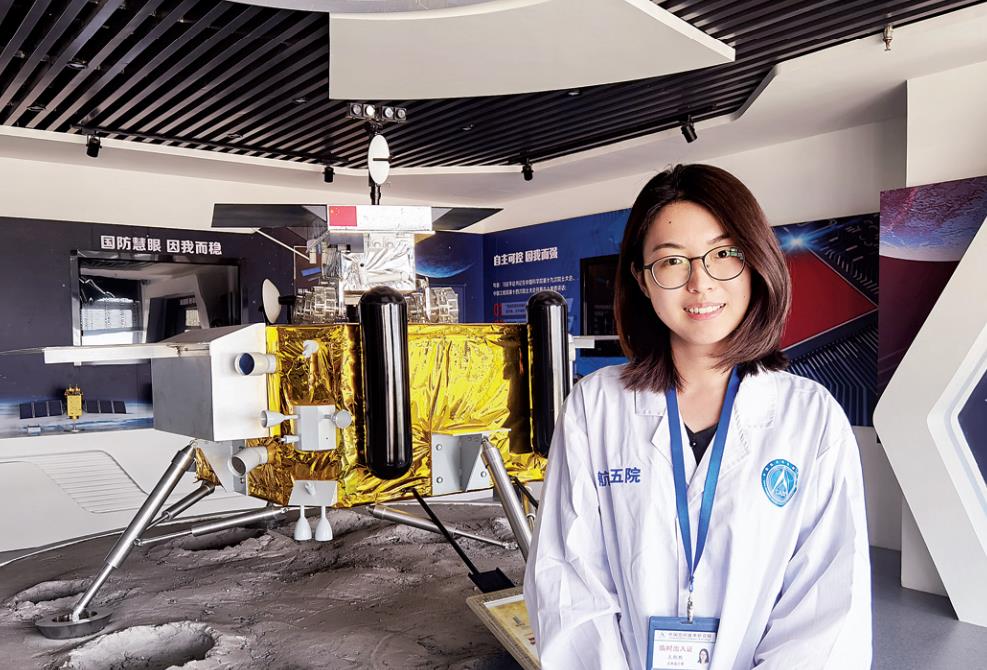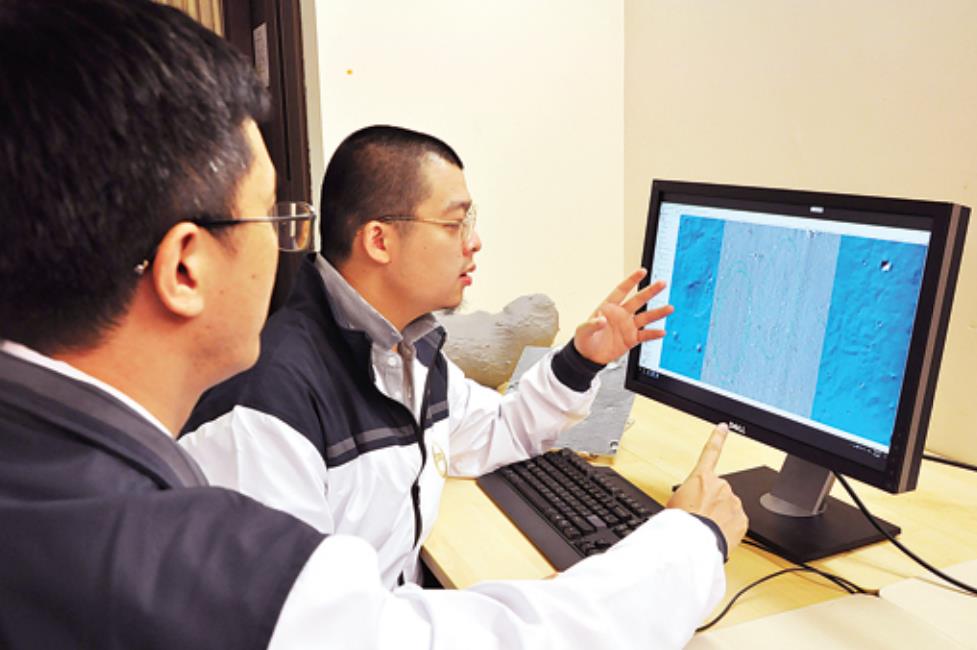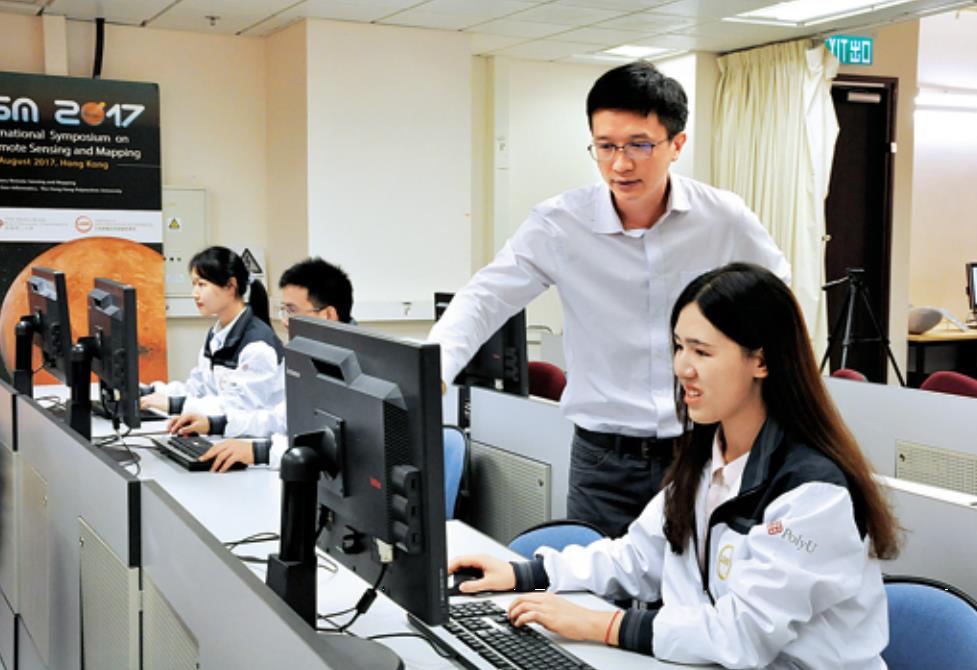
Wang Yiran, a Postdoctoral Fellow at Hong Kong Polytechnic University, stands next to a model of the Tianwen 1 Mars probe at the China Academy of Space Technology in Beijing. [Photo provided to China Daily]
Research efforts locate Tianwen 1 probe on Red Planet
Last month, a set of black-and-white photographs of a desolate desert, showing nothing but rocks, dust and craters, lay in front of Wang Yiran, a postdoctoral fellow at Hong Kong Polytechnic University.
At about the same time, China's Tianwen 1 lander was due to touch down in this desert on Mars. Wang's task was to determine the spacecraft's exact location on a planet about half the size of Earth.
A set of images taken by the lander during its nine-minute touchdown procedure had just been received by the China National Space Administration in Beijing. However, whether the probe had landed successfully had not been confirmed, as scientists and technicians had yet to locate the lander.
It could have been anywhere close to its targeted landing site, which was chosen after input from Wang and her colleagues-a 20-strong team of scientists in Hong Kong led by Wu Bo, a professor in PolyU's department of land surveying and geo-informatics.
The China Academy of Space Technology had set the team the task of analyzing the safest landing site on Mars for the spacecraft.
The location needed to be the flattest area possible, and the team's analysis was vital, as it could make or break the mission. There was no ground control during the landing, as the distance between Earth and Mars means it is impossible to control a spacecraft's descent in real time via radio signals. The landing was described by observers as "nine minutes of terror".
Wu's team stood out during the mission with its innovative topographic mapping and geomorphological analysis techniques as well as its experience. Geomorphology refers to the study of the surfaces of Earth or other celestial bodies.
The team members helped map and evaluate landing sites on the moon for China's Chang'e 4 lander in 2019 and the Chang'e 5 lander last year. The latter mission brought back samples of the lunar surface-the first time this had been achieved for 44 years.
The Tianwen 1 project began in 2016.Comprising an orbiter, a lander and the rover Zhurong-named after the god of fire in Chinese folklore-the mission was launched by a Long March 5 rocket from the Wenchang Space Launch Center in Hainan province on July 23, last year.
On joining the mission, the Hong Kong team was fully prepared for unexpected situations. The mission's field of research was much larger than that for a lunar exploration, and there was also the possibility of communications interference from the Martian atmosphere.
Wang was the only member of the PolyU team to work alongside national astronautic scientists in Beijing for the entire project. Other team members-mainly graduates, doctoral and postdoctoral students-had to remain in Hong Kong due to COVID-19 travel restrictions between the city and the Chinese mainland.
Wang arrived in Beijing soon after the probe began orbiting Mars in February. Scientific findings from the planet, captured by advanced cameras and spectrometers on the Tianwen 1 probe, were transmitted to the Chinese capital.
After receiving the findings, Wang had to send them safely to her colleagues in Hong Kong for analysis. She also represented the team at meetings with national astronautic scientists in Beijing.

Morgan Liu Wai-chung (right), a Postdoctoral Fellow at PolyU, reconstructed 2D images into 3D models to reproduce scenes of the Martian surface for the Tianwen 1 mission. [Photo provided to China Daily]
Weather worries
In addition to the findings obtained by Tianwen 1, the team's earlier work helped determine the landing area.
In 2016, the team members began analyzing the Martian surface. As a result of this work, Wu and his colleagues located a vast lava plain known as Utopia Planitia, which they targeted as an initial landing site in the planet's northern hemisphere, as it had sunny weather and flat terrain.
The team's main concern was the weather on Mars. The planet's notorious giant dust storms were looming as the northern Martian hemisphere entered summer. These storms could block sunlight powering the spacecraft and disrupt communications with Earth.
In June, 2018, bad weather put an end to the United States' robotic rover Opportunity, which failed to respond to any signals before NASA stopped sending them in February the following year.
The Hong Kong team members faced an extremely tight schedule. They had only about six weeks to conduct a thorough survey of the initial targeted 12,600-square-kilometer landing zone on Utopia Planitia. This area is about 11 times the size of Hong Kong, or two-thirds that of Beijing.
Technological challenges were faced. The Martian atmosphere, although much thinner than Earth's, affects the reflection of light and blurs images. The algorithms the team had at that time could not meet the requirements for the operation.
To reduce interference from the planet's atmosphere on the images, Morgan Liu Wai-chung, another Postdoctoral Fellow on the Hong Kong team, used his expertise to improve the algorithms.
Liu's work resulted in the algorithms transforming 2D images sent back by the probe into 3D models to reproduce scenes of the Martian surface despite atmospheric interference. The algorithms were also able to reconstruct detailed topography from single or multiple images captured by cameras.
Moreover, Wang and her teammates made full use of algorithms based on artificial intelligence that can automatically differentiate between craters and rocks through high-resolution images.
Previous algorithms, although used for lunar exploration, were not suitable for the Martian surface, as its craters had weathered worse than those on the moon, due to the Red Planet's atmosphere.
The improved algorithms developed by PolyU greatly accelerated the team's laborious work, which took in 670,000 craters, more than 2 million rocks and hundreds of volcanic cones spread throughout the targeted landing area. Without the improvements, these tasks would have taken years to complete. In 2013, it took a dozen PolyU students more than three months to "hand-pick "all potential obstacles within a much smaller landing area for the Chang'e 3 lunar mission.
Pressed for time, the Hong Kong team worked as if it were running a relay race. "Everybody was always ready to answer calls and to take over work," Wang said.
During the mission, Liu slept only four hours a day-the least among the team members, but his hard work paid off, as he produced one of the most accurate and detailed models for the targeted landing zone on Mars. The high-resolution cameras aboard Tianwen 1, which were developed by China and had a resolution of about 0.7 meters-10 times that of those on Chang'e 2-also contributed to Liu's work. Chang'e 2 was launched by a Long March 3C rocket on Oct 1, 2010.
The team's stress levels peaked the night before the scheduled landing. The volume of final data was so large that one researcher stayed up all night to analyze it, while others volunteered to remain in the laboratory to assist with this work.
When Wang put the results together and submitted them to Wu next morning, the professor had just three hours to analyze them and present them to the authorities in Beijing.
Based on the team's data, Wu recommended to Beijing the three safest oval-shaped areas within the targeted landing zone. He assessed the pros and cons of all options, using data, diagrams and logic.
Wang heard one senior official commenting on the plan, describing the team's work as "neat and deft" and saying the members had done well. Everyone appeared satisfied with the team's contribution.
Among the three landing areas suggested, Beijing settled for Area No 16, as it was the least-risky site found by the team, which had now accomplished its mission. However, Wang had to wait for further instructions until the big day-the landing.
When she received the first group of images transmitted to Earth after the landing, Wang, who was familiar with the Martian craters, instantly recognized their location. Her contribution helped significantly narrow the search for the lander using the cameras on the Tianwen 1 orbiter.
Wang's achievement was no coincidence. When she was assigned to help locate the lander, the 27-year-old scientist trained herself to memorize the features of the entire landscape, until each crater became as familiar "as the faces of friends".
A major announcement by China's space agency followed: "The lander of China's Tianwen 1 mission landed successfully on Mars in the early morning of May 15." The coordinates of the landing site were 25.1 degrees north and 109.9 degrees east.
The successful orbiting, landing and roving of Mars during a single mission marked a milestone in China's deep-space planetary exploration, making the country only the second nation after the United States to land and operate a rover on Mars.

Wu Bo (standing) led the PolyU team that helped map and evaluate landing areas for the mission. [Photo provided to China Daily]
Dedicated efforts
Back in Hong Kong, Wu and his team members were overjoyed. "The Tianwen 1 mission is a huge project, and we're only a small part of the efforts of thousands of people in supporting the mission's accomplishments. All my team members were fully dedicated to the undertaking over the past months," he said.
The team members were also impressed that the Tianwen 1 lander ended up touching down close to the center of the targeted area-an engineering feat that transformed their findings into reality.
The team's jubilation and pride were shared by PolyU staff members and Hong Kong's scientific academia.
Scientists from the university have taken part in the nation's space programs since 2004. Along with Wu's team, another from PolyU, led by Yung Kai-leung, associate head of the department of industrial and systems engineering, developed a surveillance camera fixed to the Tianwen 1 lander. The camera monitored the landing and photographed the surrounding environment.
Weighing 390 grams-equivalent to two iPhone 11s-the camera had to withstand an impact force about 6,200 times that of Earth's gravity. "I'm so glad it didn't break into bits," Yung joked at a news conference last month.
Liu said, "Given more time, we could have done it better," adding that he went to bed an hour early to celebrate the successful landing.
For Wang, being part of the nation's space program is more like a reward for a scientific researcher than a call of duty. Hailing from Shandong province, she began her doctoral studies in Hong Kong in 2016 at the start of the Mars project.
The world-class project, a highlight of her doctoral and postdoctoral days, was her perfect graduation gift. If she is offered opportunities to take part in other such missions, Wang said she will have no hesitation in accepting. "I can't see a single reason for me not to. It'll be a gift-why not take it," she added.
Wang recalled Wu's inspiring words when he heard news of the successful landing: "We're not only witnessing history, we're part of history."
Wu is now setting his sights on the next national space project, including the exploration of near-Earth asteroids, which is scheduled within the next five years, or collecting samples from Mars in 10 years' time.
The success of the nation's Mars probe has heightened the expectations of humankind, including young minds.
Shortly after the launch of Tianwen 1, Wu's 9-year-old daughter, who attends elementary school in Hong Kong, was given a drawing assignment for homework, in which students were asked to develop a "wild imagination of human life on Mars in the future".
For many people, the end of this mission is just the beginning of more possibilities.

A photo released on June 11 by the China National Space Administration shows Zhurong, the nation's first Mars rover, on the surface of the planet. The rover is named after the Chinese god of fire. [Photo provided to China Daily]

